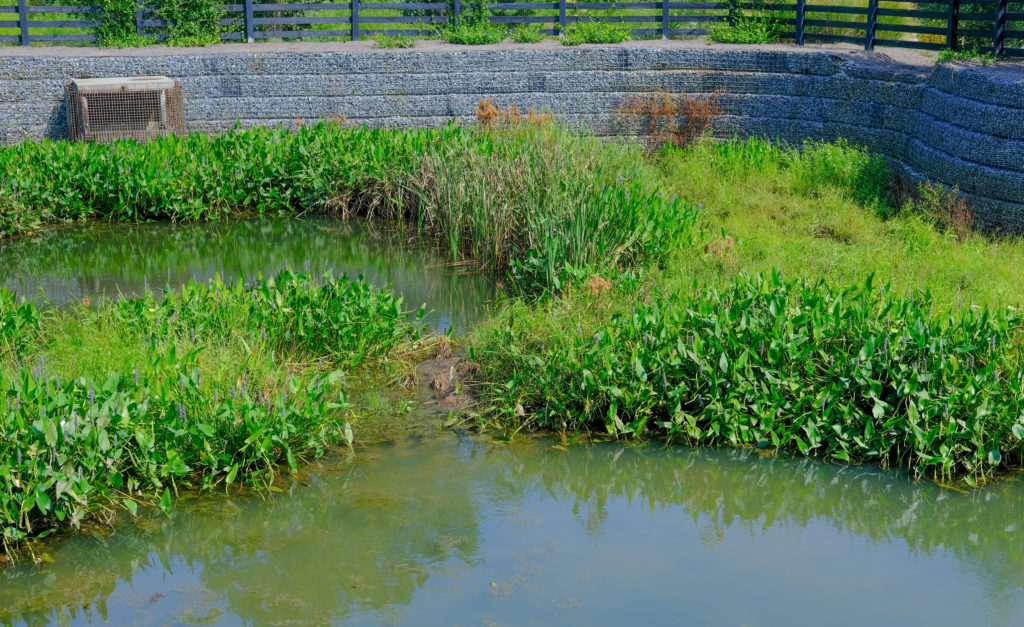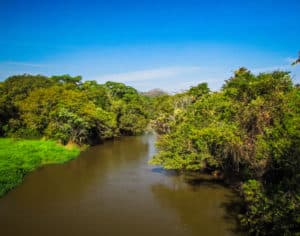A stormwater basin (sometimes referred to as a detention basin or a detention pond) is a man-made area of graded earth that is designed to collect and manage stormwater runoff after a rainfall event.
Unlike a natural pond that continually holds water, a stormwater basin normally holds water temporarily. During a heavy storm, you might see a stormwater basin fill up with water before the water level in the basin starts to decrease until the basin empties after a certain number of hours or days depending on how the basin was designed.
Stormwater basins exist to control and manage stormwater runoff with regard to runoff rates, water quantity, and water quality.
How Water Is Conveyed to a Basin
In order for a stormwater basin to function correctly, runoff has to be able to get to the basin. Water gets to a basin through a series of swales, storm drains, and storm sewer pipes that are designed usually by a civil engineer along with the design of the basin itself.
A basin can function correctly only if the stormwater runoff within the drainage area for which the basin is designed can actually get to the basin.
The Components of a Stormwater Basin
The following are the components that are common to most stormwater management basins.
1) Embankment – This is the earthen fill material that is placed along the downstream side of a basin. The material used for this is usually cut material obtained from the upstream side of the basin.
2) Emergency spillway – This is a section cut into the top of the embankment used to allow water to escape the basin when the primary outlet structure is clogged.
3) Outlet structure – This is a usually some sort of storm drain structure with a grate and one or more orifices along one of the sides of the structure and is used to regulate the outflow from the basin.
4) Outlet pipe – The outlet pipe carries the flow from the outlet structure to an energy-dissipating measure such as a riprap apron or a level spreader.
Factors Involved in Designing a Stormwater Basin
Designing a stormwater basin is a complicated process that involves careful planning as part of a land development project.
The main factor is the hydrology of the land being developed in the pre-development and post-development condition especially with regard to the amount of increase in impervious area that would result after construction of the project. A large increase in impervious area could mean a large stormwater basin.
Related: What Is Impervious Area in Land Development?
Another factor in the design of a stormwater basin is the amount of land available to construct a basin. If it is found there is not enough room reserved for the stormwater management area to grade and build the basin to the required size, the proposed impervious areas might have to be decreased or a different stormwater management system might have to be chosen.
The Steps Involved in Designing a Stormwater Basin
The following are the main steps involved with the design of a stormwater basin.
1) Research local ordinances to determine stormwater management requirements.
2) Prepare hydrology calculations and other calculations required for sizing the basin.
3) Prepare the grading design for the proposed basin.
4) Design any required swales and storm drainage systems.
A Main Consideration in a Land Development Project
Because it is a common method chosen for stormwater management, the design of a stormwater basin is something that should be considered as a part of the planning for the proposed layout for a new land development project.
Related: How to Create a Land Development Design (In 12 Steps)
Related: 10 Common Terms Used in Stormwater Management
Related: Stormwater Management (A Guide for the Non-Professional)



